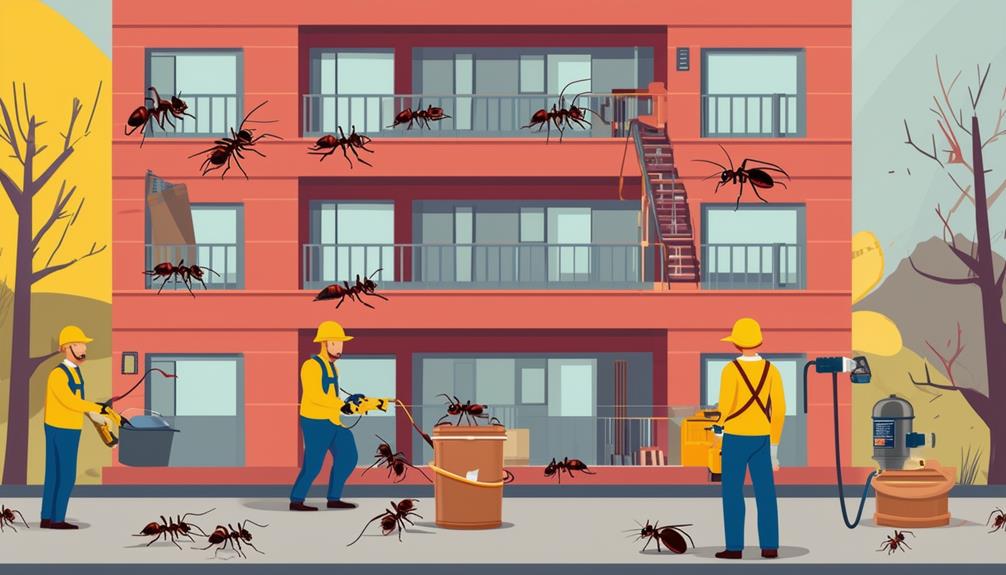When summer arrives in Utah, it brings not only warmth and sunshine but also the potential for unwelcome guests in your home. From tiny ants marching through your kitchen to pesky mosquitoes buzzing around your yard, pests can quickly disrupt your peace. By following a simple seasonal checklist tailored to Utah's unique pest challenges, you can proactively defend your home against these invaders. Stay tuned to discover essential tips and tricks to keep your living space pest-free this summer.
Key Takeaways
- Conduct a thorough exterior inspection to seal entry points and prevent pest infestations.
- Maintain a pest-resistant yard by trimming shrubs, eliminating standing water, and using pest-repelling plants.
- Remove standing water sources to deter mosquito breeding and ensure proper yard drainage.
- Implement indoor cleaning and pest-proofing strategies like decluttering, sealing cracks, and storing food properly.
- Consider natural pest control methods and professional services for effective and eco-friendly pest management.
Pest Identification
When preparing your Utah home for summer pests, it's important to accurately identify common intruders like ants, spiders, wasps, mosquitoes, and cockroaches. Recognizing these pests is the first step in effective pest control.
Understanding the signs of pest infestation, such as droppings, nesting materials, and visible damage, can help you address issues promptly. It's vital to differentiate between harmful pests, like mosquitoes and cockroaches, which can pose health risks, and nuisance pests, such as ants and spiders, which are mostly bothersome.
Consulting with local pest control experts can provide valuable insights into the specific pest issues in your area. By learning about pest behavior and biology, you can implement targeted pest control strategies for a pest-free home.
Identifying these pests accurately will enable you to take the necessary measures to prevent infestations and protect your home from potential damage and health hazards.
Exterior Inspection
To effectively safeguard your Utah home against summer pests, begin by conducting a thorough inspection of the exterior for potential entry points and signs of pest activity. Inspect the outer walls, siding, and foundation for any cracks, crevices, or gaps that could serve as entry points for pests like ants, spiders, or rodents. Check for damaged or loose siding, vents, and screens that may provide easy access for pests seeking shelter or food. Pay close attention to any signs of pest activity such as chewed wood, droppings, or nests around the exterior of your home.
Ensure that all doors, windows, and areas where utilities enter the home are properly sealed to prevent pest intrusion. Use materials like caulk or weatherstripping to seal off any openings that pests could exploit. By addressing these potential entry points and conducting a thorough exterior inspection, you can greatly reduce the likelihood of pests finding their way into your home this summer.
Yard Maintenance
Inspecting and maintaining your yard plays a significant role in deterring pests from infiltrating your Utah home during the summer months. To effectively manage pests in your yard, follow these essential yard maintenance tips:
- Trim Shrubs and Trees: Keeping shrubs and trees well-maintained can prevent pests from easily accessing your home and creating entry points for insects.
- Eliminate Standing Water: Make sure your yard is free of standing water to eliminate breeding grounds for mosquitoes, reducing the risk of mosquito-borne diseases.
- Regularly Mow the Lawn: By consistently mowing your lawn, you can reduce hiding spots for insects like ants and ticks, making your yard less hospitable to pests.
- Plant Pest-Repelling Herbs: Incorporate pest-repelling herbs such as mint, lavender, and basil into your yard. These plants naturally deter insects, creating a more pest-resistant environment.
Standing Water Removal
To effectively combat mosquito breeding grounds around your home, it's essential to eliminate standing water sources.
Preventing water accumulation in areas like clogged gutters, flower pots, and bird baths is vital in reducing the risk of mosquito infestations.
Mosquito Breeding Grounds
Mosquitoes, those pesky summer pests, lay their eggs on the surface of standing water, making it crucial to eliminate any stagnant water sources around your home to prevent their breeding. Here are essential steps to address mosquito breeding grounds:
- Remove Standing Water: Regularly check and empty containers such as flower pots, bird baths, and clogged gutters where water can accumulate.
- Prevent Water Accumulation: Make sure there's proper drainage in your yard to prevent water from pooling.
- Cover Water Storage: Keep containers like rain barrels tightly covered to hinder mosquitoes from accessing the water.
- Maintain Pools: If you have a pool, ensure it's properly maintained and treated to prevent mosquito breeding.
Taking these steps can greatly reduce mosquito populations around your home.
Preventing Water Accumulation
In order to effectively prevent water accumulation around your home, it's essential to consistently check and address potential areas of standing water where mosquitoes and other pests could breed.
Standing water serves as a breeding ground for mosquitoes, which are carriers of diseases such as West Nile virus and Zika virus. Make sure to remove any standing water from flower pots, bird baths, clogged gutters, and other containers to deter mosquito breeding.
Regularly inspect your yard for water accumulation post-rainfall or irrigation to mitigate the risk of pest infestations. Proper drainage in outdoor spaces is important to prevent standing water build-up near your home.
Prompt removal of standing water is essential for pest control, as it also attracts other pests like ants, cockroaches, and rodents.
Sealing Entry Points
You can start by carefully examining your home's exterior for any cracks or gaps that pests could use to sneak inside. Using weatherstripping and caulking, you can effectively seal off these entry points and make it harder for pests to invade your living space.
Installing door sweeps and window screens can also act as barriers against insects and rodents seeking refuge in your home.
Identify Potential Entryways
To effectively prevent pests from infiltrating your home during the summer months, meticulous inspection and sealing of potential entry points such as cracks in walls, windows, doors, and foundation is essential. Here are some steps you can take to identify and seal these potential entryways:
- Inspect Walls: Check for any cracks or gaps in the walls, especially around utility lines and pipes that enter your home.
- Examine Windows: Inspect the window frames for gaps or damaged seals that pests could use to enter.
- Check Doors: Make sure that doors are properly sealed, including the areas around the door frames and thresholds.
- Evaluate Foundation: Look for any cracks or holes in the foundation that pests could exploit to get inside.
Use Weatherstripping to Seal
Using weatherstripping to seal entry points is an essential and cost-effective method to prevent pests from entering your home while also improving energy efficiency.
Weatherstripping, made of materials like foam, rubber, or vinyl, effectively seals gaps around doors and windows, acting as a barrier against pests.
By sealing entry points with weatherstripping, you not only keep pests out but also reduce energy loss, leading to lower utility bills. Additionally, properly sealed entry points enhance indoor air quality by preventing dust and allergens from infiltrating your living space.
Regularly checking and replacing worn weatherstripping is vital to maintaining protection against pests and ensuring a comfortable and healthy home environment.
Food Storage Solutions
Implementing airtight containers for food storage is an effective strategy to prevent pests such as ants and pantry moths from infiltrating your pantry. To further safeguard your home against unwanted invaders, follow these food storage solutions:
- Seal Food in Airtight Containers: Utilize sealed containers to store all types of food, including pet food, fruits, and vegetables. This helps to prevent pests like rodents, insects, and fruit flies from being attracted to your pantry.
- Store Fruits and Vegetables Properly: Keep fruits and vegetables either in the refrigerator or sealed containers to deter pests like fruit flies.
- Maintain Clean Surfaces: Regularly clean kitchen surfaces and floors to eliminate food crumbs that may attract pests such as cockroaches and ants.
- Dispose of Garbage Properly: Make sure garbage is disposed of in tightly sealed bins to avoid odors that can draw in flies, rodents, and other pests.
Indoor Cleaning Tips
When it comes to pest-proofing your indoor spaces, decluttering is key to preventing pests from finding hiding spots.
Vacuuming and mopping floors regularly can help eliminate crumbs and spills that attract insects and rodents.
Be sure to seal any cracks or gaps around windows, doors, and pipes to keep pests from sneaking into your home.
Pest-Proofing Indoor Spaces
To effectively pest-proof indoor spaces, start by utilizing a vacuum with a HEPA filter to thoroughly eliminate dust, dander, and pest debris. Here are some essential steps to keep pests at bay:
- Seal Cracks: Inspect and seal cracks and crevices around windows, doors, and pipes to prevent indoor and outdoor pests like ants, spiders, and cockroaches from entering.
- Store Food: Store food in airtight containers to eliminate food sources for pests such as pantry moths and rodents.
- Declutter and Organize: Reduce hiding spots for pests like silverfish, beetles, and mice by decluttering and organizing storage areas.
- Clean Regularly: Regularly clean and disinfect kitchen and bathroom areas to deter pests attracted to moisture and food residue.
Declutter for Prevention
Inspecting and decluttering your living spaces plays an essential role in preventing pest infestations and improving the effectiveness of pest control measures. Clutter provides hiding spots and nesting areas for pests like rodents and insects, attracting them to seek shelter and food in your home.
By regularly decluttering, you can reduce the risk of pest infestations and enhance pest control efforts. Store items in sealed containers to limit pests' access to food and nesting materials. Keeping your home tidy and organized not only minimizes pest attraction but also reduces breeding opportunities.
Prioritize organization and cleanliness in your living spaces to create an environment that's less hospitable to pests, ultimately safeguarding your home from potential infestations.
Natural Pest Control Methods
Implementing natural pest control methods in your home can effectively manage pests without the use of harmful chemicals. Here are some environmentally friendly solutions to help you combat pests naturally:
- Essential Oils: Utilize essential oils such as peppermint, lavender, and tea tree oil to repel insects like ants, mosquitoes, and spiders.
- Pest-Repelling Herbs: Plant herbs like basil, mint, and rosemary around your home to naturally deter pests.
- Diatomaceous Earth: Use diatomaceous earth, a non-toxic powder made from fossilized algae, to control pests like bed bugs, ants, and cockroaches.
- Sticky Traps: Employ sticky traps made from natural materials like cardboard and non-toxic adhesive to capture insects without the use of harmful chemicals.
Professional Pest Control Services
Hiring professional pest control services in Utah guarantees the tailored treatment of pests to safeguard your home effectively. These services offer personalized plans to address specific pest issues, utilizing trained technicians who specialize in eradicating common pests like ants, spiders, rodents, and termites from Utah homes. By employing eco-friendly solutions, Utah pest control companies ensure minimal environmental impact while efficiently dealing with infestations. Regular pest control not only eliminates existing pests but also acts as a preventive measure, protecting your home from potential structural damage caused by these intruders. With long-term solutions provided by professional pest control services, you can enjoy a pest-free home throughout Utah's summer months, ensuring the safety and comfort of your family. Take a look at the table below to understand the benefits of professional pest control services in Utah:
| Benefits | Professional Pest Control Services in Utah |
|---|---|
| Customized Treatment Plans | ✔ |
| Trained Technicians | ✔ |
| Eco-Friendly Solutions | ✔ |
| Long-Term Protection | ✔ |
Ongoing Pest Prevention
To maintain a pest-free home during the summer months in Utah, consistent vigilance and proactive measures are crucial in deterring unwanted intruders. Here are some key steps you can take to guarantee ongoing pest prevention:
- Inspect: Regularly check your home for any cracks or entry points that pests could use to gain access. Seal up these openings to prevent pests from entering.
- Clean: Keep outdoor areas tidy and free of debris to eliminate potential pest habitats. Removing clutter can help discourage pests from establishing nests near your home.
- Store: Properly store food in airtight containers to avoid attracting pests like ants and rodents. Securely sealing food can help prevent infestations in your kitchen.
- Trim: Trim trees and shrubs away from your home to prevent pests from using them as pathways. Overhanging branches can serve as bridges for pests to easily enter your home.
Frequently Asked Questions
What Regular Maintenance Does a House Need?
You need to stay on top of regular maintenance for your house. From pest prevention to outdoor cleaning, interior checks, landscaping maintenance, and weatherproofing strategies, keeping your home in top shape is essential.
How Do I Prepare My House for Fall Season?
To prepare your house for the fall season, follow these pest-proofing tips: seal entry points, replace weather stripping, clean your yard, fix leaks, and trim plants. These steps will keep pests out and guarantee a pest-free home.




